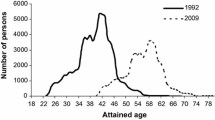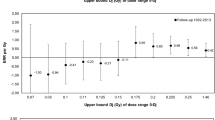Abstract
The paper presents estimates for the latent period of the induction of radiogenic solid cancers among Chernobyl emergency workers (males) living in six central regions of Russia. The analysis is based on medical and dosimetry data gathered by the National Radiation and Epidemiological Registry over the time period from 1986 to 2005. The cohort includes 59,770 persons who stayed in the exposure zone (30-km zone around the Chernobyl nuclear power plant) in 1986–1987. There were 2,718 cases of solid tumors identified during the follow-up time in this cohort. The mean radiation dose in the cohort is 0.13 Gy. The radiation risk and latent period were estimated using the method of maximum likelihood. The excess relative risk per unit dose was found to be 0.96 (95% confidence interval (CI): 0.3–1.7) and the minimum latent period for induction of solid tumors is 4.0 years (95% CI: 3.3–4.9).




Similar content being viewed by others
References
Committee to Assess Health Risks from Exposure to Low Levels of Ionizing Radiation (2006) Health risk from expose to low levels of ionizing radiation: BEIR VII, phase 2: National Research Council of the National Academies. The National Academies Press, Washington, pp 486–488
Cox DR (1975) Partial likelihood. Biometrica 62:269–276
Cox DR, Hincley DV (1974) Theoretical statistics. Chapman & Hall, London
Heidenreich WF, Kenigsberg Y, Jacob P, Buglova E, Gulko G, Paretzke HG, Demidchik EP, Golovneva A (1999) Time trends of thyroid cancer incidence in Belarus after Chernobyl accident. Radiat Res 151:617–625
Ivanov VK, Tsyb AF, Gorsky AI, Maksioutov MA, Rastopchin EM, Konogorov AP, Biryukov AP, Matiash VA, Mould RF (1997a) Thyroid cancer among “liquidators” of the Chernobyl accident. Br J Radiol 70:937–941
Ivanov VK, Tsyb AF, Gorsky AI, Maksioutov MA, Rastopchin EM, Konogorov AP, Korelo AM, Matiash VA (1997b) Leukaemia and thyroid cancer in emergency workers of the Chernobyl accident: estimation of radiations risks (1986–1995). Radiat Environ Biophys 36:9–16
Ivanov VK, Rastopchin EM, Gorsky AI, Ryvkyn VG (1998) Cancer incidence among liquidators of the Chernobyl accident: solid tumors, 1986–1995. Health Phys 74:309–315
Ivanov VK, Gorski AI, Tsyb AF, Maksioutov MA, Souchkevich GN (2001) Mortality among the Chernobyl emergency workers: estimation of radiation risks (preliminary analysis). Health Phys 85(5):514–521
Ivanov VK, Gorski AI, Tsyb AF, Ivanov SI, Naumenko RN, Ivanova LV (2004) Solid cancer incidence among the Chernobyl emergency workers residing in Russia: estimation of radiation risks. Radiat Environ Biophys 43:35–42
Ivanov VK, Gorski AI, Tsyb AF, Maksioutov MA, Tumanov KA, Vlasov OK (2006) Radiation-epidemiological studies of thyroid cancer incidence among children and adolescents in the Bryansk oblast of Russia after the Chernobyl accident (1991–2001 follow-up period). Radiat Environ Biophys 45(1):9–16
Kasakov VS, Demidchik EP, Astakhova LN (1992) Thyroid cancer after Chernobyl. Nature 359(6390):21–22
Lederman W (ed) (1984) Handbook of applicable mathematics, vol 6: statistics, part A. Wiley, New York
Preston DL, Ron E, Tokuoka S, Funamoto S, Nishi N, Soda M, Mabuchi K, Kodama K (2007) Solid cancer incidence in atomic bomb survivors: 1958–1998. Radiat Res 168(1):1–64
Report of the NCI-CDC working group to revise the 1985 NIH Radioepidemiological Tables (2003) National Cancer Institute, National Institute of Health. NIH publication No. 03-5387, pp 9–11
UNSCEAR (United Nations Scientific Committee on the Effects of Atomic Radiation) (2008) Effects of ionizing radiation: UNSCEAR 2006 report to the general assembly, with scientific annexes, vol 1. United Nations, New York, pp 40–42
Author information
Authors and Affiliations
Corresponding author
Appendix 1
Appendix 1
If the number of unknown quantities θ 1, θ 2,…,θ p is more than one, the joint sample distribution of the likelihood maximum estimate is asymptotically normal, with the mathematical expectancy θ 1 , θ 2 ,…,θ p and the covariance matrix A −1 (Lederman 1984), where the (r,s)-th element of the matrix A is approximately equal to \( \frac{{ - \partial^{2} { \ln }(lik)}}{{\partial \theta_{r} \partial \theta_{s} }}, \) s, r = 1,2,…,p.
In case of two unknown quantities the covariance matrix of the likelihood maximum estimate can be written as (9):
where \( \sigma_{1}^{2} ,\sigma_{2}^{2} \) are the sample variances of the estimates \( \hat{\theta }_{1} ,\hat{\theta }_{2} , \) and ρ is the sample correlation coefficient.
Then, the approximate covariance matrix will take the form shown in (10) (−1 is the sign of the reverse matrix):
The elements of matrix (10) are written as given in 11, 12 and 13:
where \( B2(T)_{j} = \sum\limits_{i = 1}^{N} {\sum\limits_{k = 1}^{{t_{i} }} {{\text{PY}}_{{g_{i} + k}} } } S^{\prime\prime}(x_{j} )d_{i} . \)
The approximate joint confidence region for the quantities β and T of the ellipse shape is written as in (14) (Lederman 1984):
where the coefficient γ defines the boundaries of the confidence region.
The values \( \hat{\beta },\hat{T} \) are the estimates of the quantities derived by solving the system of equations (8). The value γ is found from (15):
For the 95 % confidence interval ξ = 0.95, the value γ = 5.99.
Hence, all the values of β and T for which the left side of (14) is less than the right one, will occur within the joint confidence region.
Rights and permissions
About this article
Cite this article
Ivanov, V.K., Gorsky, A.I., Kashcheev, V.V. et al. Latent period in induction of radiogenic solid tumors in the cohort of emergency workers. Radiat Environ Biophys 48, 247–252 (2009). https://doi.org/10.1007/s00411-009-0223-2
Received:
Accepted:
Published:
Issue Date:
DOI: https://doi.org/10.1007/s00411-009-0223-2




